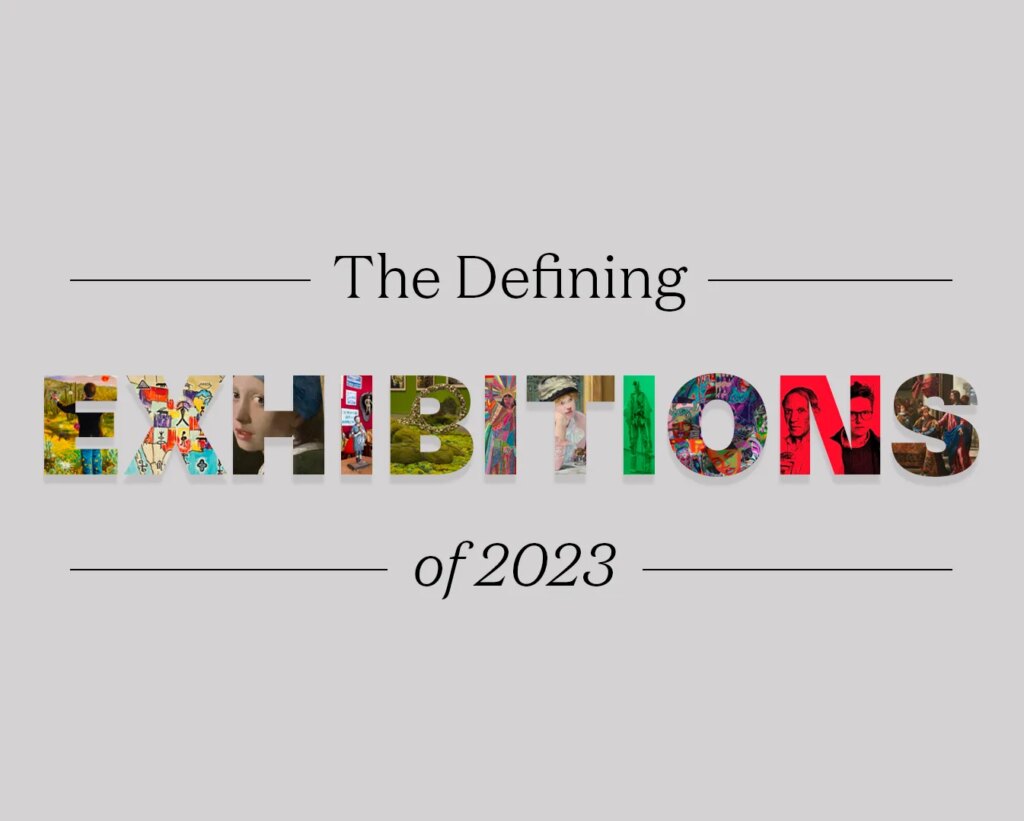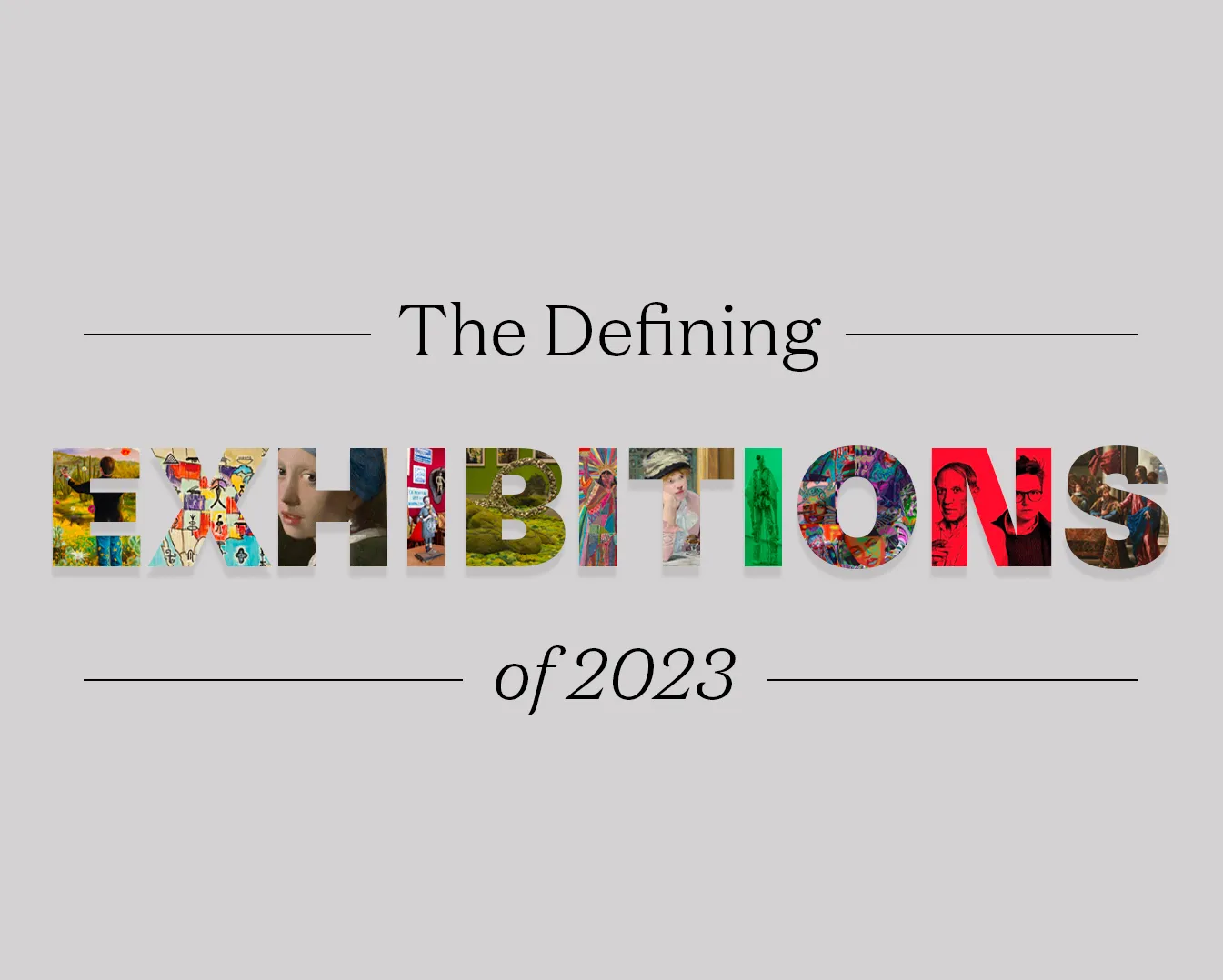
Three years after many institutions promised to diversify their offerings and start anew, signs of an expanded canon have finally arrived. Some of the biggest shows of 2023 were ones that made significant contributions to art history: surveys of contemporary Indigenous art, a vast exhibition of Black Brazilian art, and in-depth explorations of figures who had largely been relegated to the margins.
Which is not to say that grand blockbusters didn’t happen. There was a Vermeer retrospective that had been awaited for years, and Édouard Manet’s Olympia visited the US for the first time ever as part of a Manet-Degas double-header. That both kinds of exhibitions could coexist, sometimes even within the walls of the same institution, demonstrated just how much the remit of major museums has changed in the past few years.
Below, a look at the 25 exhibitions which defined 2023.
-
‘Vermeer’ at Rijksmuseum, Amsterdam
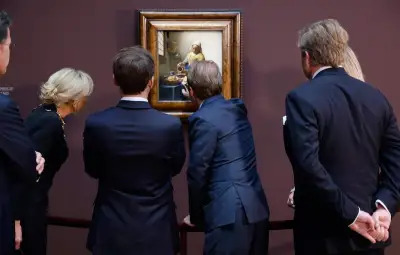
Image Credit: Photo Ludovic Marin/AFP via Getty Images Sometimes a blockbuster show is a victim of its own success. This was the case with this Vermeer retrospective featuring 28 paintings by the Dutch Old Master, including seven works never seen before in the Netherlands. Massive public interest resulted in tickets selling out within three days of its opening, unverified eBay listings marketed tickets priced as highly as $2,724, and the sale of more than 100,000 copies of the official catalogue. Even extended hours couldn’t satisfy demand for the show, which was widely understood to be a once-in-a-lifetime chance to see works that are rarely loaned. “Vermeer” captured the public’s eye in a big way—and shows that museums may need to prepare for even greater demand for exhibitions like this one in the future. —Karen K. Ho
-
‘It’s Pablo-matic: Picasso According to Hannah Gadsby’ at Brooklyn Museum, New York
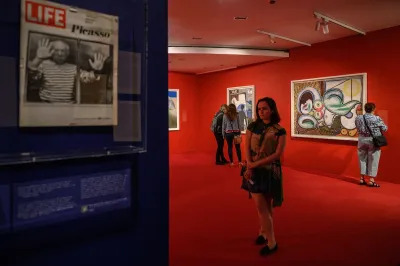
Image Credit: Photo Ed Jones/AFP via Getty Images Sometimes, a truly awful exhibition still manages to be extremely significant. Like it or not, that is the case with “It’s Pablo-matic,” which exemplified the revisionary mindset being applied to modernist men right now while also showing just how low museums will stoop in order to reach a mass audience. The show was one of many held this year to mark the 50th anniversary of Picasso’s death, and it arguably had the hardest edge. Comedian Hannah Gadsby had already explained her issues with Picasso in their hit 2018 Netflix special Nanette: they found his abuse of women repugnant, and yet were taught they had to worship at his altar because his art was so formally innovative. This show was meant to elucidate their views even more, now with Picasso artworks on hand from the Musée Picasso, the Museum of Modern Art, and elsewhere.
The show made a fair case for how Picasso’s art thrived on violence toward women, but it faltered in how it went about its argument. Punny, irreverent texts from Gadsby accompanied these paintings and prints, watering down salient analyses with laughably bad jokes. A range of feminist art, by the likes of Dindga McCannon, Faith Ringgold, and Ana Mendieta, was also here, but little of it had much to do with Picasso, anyway. I panned the show, as did many others. Crowds amassed to see “It’s Pablo-matic” anyway. The Brooklyn Museum’s populism worked. But at what cost? —Alex Greenberger
-
‘Sophie Calle: À toi de faire, ma mignonne’ at Musée Picasso, Paris
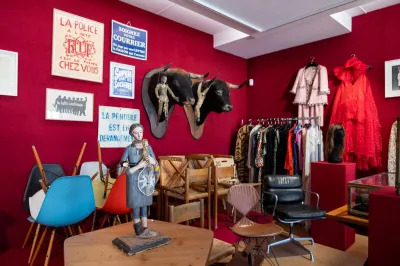
Image Credit: Photo Vinciane Lebrun/Voyez-Vous; Art: ©2023 Sophie Calle/ADAGP, Paris When Sophie Calle was invited to show at Paris’s Musée Picasso, she put all of Picasso’s things into the basement, and moved everything she owned into the museum. Why, you might ask? Because she couldn’t stand to show her work next to his, and because thinking about his lofty legacy made her think about her own death—what she will leave behind, what will become of her things. Impressively, the show also doubles as a retrospective of sorts—one that explores a lifetime of ideas by the famed French conceptualist. —Emily Watlington
-
‘The Land Carries Our Ancestors: Contemporary Art by Native Americans’ at National Gallery of Art, Washington, D.C.
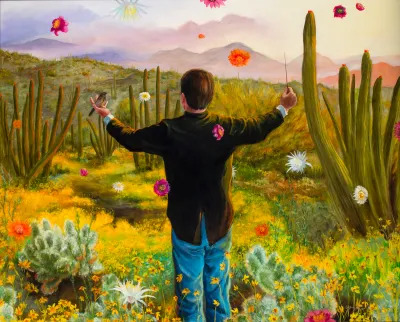
Image Credit: ©2003 Steven J. Yazzie/Photo Craig Smith/Courtesy Heard Museum In an interview with Art in America, Jaune Quick-to-See Smith explained that she intended her Whitney Museum retrospective to be “a celebration that would go beyond me, like ripples in the stream. I hope that it will open the door so that other Native artists can have exhibitions there and elsewhere.” In that spirit, Quick-to-See Smith curated a survey bringing together the work of nearly 50 Native American artists from across the US, with a wide range of mediums—weaving, sculpture, beading, painting, performance, drawing, and video—highlighting Indigenous understandings of the North American landscape. Kay WalkingStick’s painting Ute’s Homelands (2022) depicts the grandeur of an American Southwest landscape overlaid with Native designs, while Cara Romero’s wide-format photograph Indian Canyon (2019) shows a child wearing a headdress in a rocky Southern California terrain––both in acknowledgement of the Indigenous peoples who came ahead of Western settlers. Part of a wave of institutional exhibitions surveying contemporary Native American art, “The Land Carries Our Ancestors” marks a long-overdue renewed focus on contemporary Native American art and artists. —Francesca Aton
-
‘Jaune Quick-to-See Smith: Memory Map’ at Whitney Museum, New York
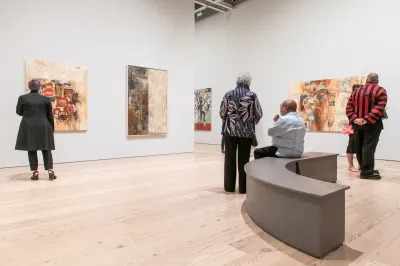
Image Credit: Photo Matthew Carasella Jaune Quick-to-See Smith, a Flathead Salish member of the Confederated Salish and Kootenai Tribes in Montana, has pushed the boundaries of Native American art since the 1970s with her expansive art practice, environmental activism, and work as an educator. Her retrospective at the Whitney, billed as the first one devoted to an Indigenous artist that the museum has ever organized, attested to the breadth of her vision. It brought together five decades of Smith’s drawings, prints, paintings, and sculptures—including her iconic painting Memory Map (2000), which places pictographs related to Native tribes across a map of the US. In her remapping of America, Quick-to-See Smith reminds viewers that these sites and geographical areas existed for Indigenous peoples long before colonizers implemented borders on them. —Francesca Aton
-
‘The Culture: Hip Hop and Contemporary Art in the 21st Century’ at Baltimore Museum of Art and Saint Louis Art Museum
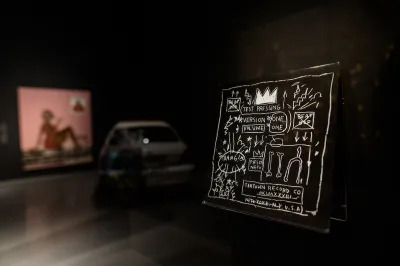
Image Credit: Photo Rosem Morton/The Washington Post via Getty Images In a year with no shortage of commemoration related to the birth of hip-hop a half-century ago, this crowd-pleaser pulled together an impressive mix of artworks and mementoes that truly got to the interdisciplinary, cross-cultural swirl at the core of a musical movement that is so much more. The modes of display were dynamic and lively without tipping over into spectacle, and the connections proffered between the art on view—by a starry cast including Joyce J. Scott, Lauren Halsey, Stan Douglas, Deana Lawson, Gordon Parks, and Arthur Jafa, among many others—and hip-hop itself were clear without being overly obvious. —Andy Battaglia
-
‘Juan de Pareja: Afro-Hispanic Painter’ at Metropolitan Museum of Art, New York
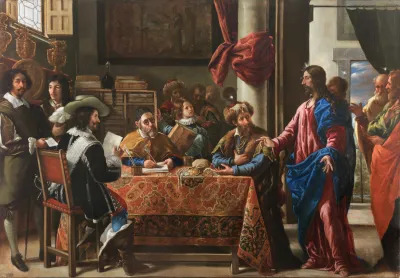
Image Credit: The Prado Museum, Madrid This memorable show spotlit Juan de Pareja, a painter often overshadowed by a Diego Velázquez portrait of him that is owned by the Met. More than just the subject of masterpiece, de Pareja was a painter of formidable talent himself, and the exhibition presented some of the few known works by him alongside portraits by eminent Spanish artists like Zurbarán and Murillo. Beyond de Pareja’s artistry, however, the Met also explored him as a person born in a multiracial Spain, with a focus on the Black and Morisco communities he may have known. The exhibition, along with a complementary de Pareja show at the Hispanic Society, made a compelling case for why he deserves a more significant place within art history. —Daniel Cassady
-
‘Manet/Degas’ at Musée d’Orsay, Paris, and Metropolitan Museum of Art, New York
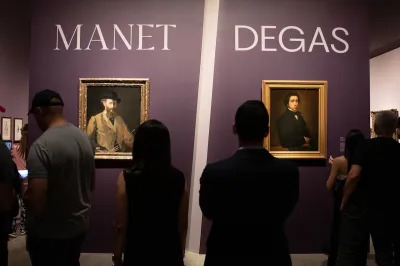
Image Credit: Photo Liao Pan/China News Service via Getty Images The parallel yet distinct trajectories of two 19th-century art icons form the basis of this fascinating show, which reveals not merely their similarities but also their stark differences. Manet, the revolutionary, employed chunky brushstrokes, relishing in the physicality of paint, always aspiring toward monumental statements. In contrast, Degas, the draftsman, revered paint for its fluidity, prized atmosphere and less grand imagery. Periodically, the two converged—both painted portraits, seascapes, and more—but their divergent approaches to paint and artistic philosophy lent this show a special tension. Its melancholic last room, featuring Degas’s collection of Manet’s art, suggests a fascination that is still palpable more than a century on. —Daniel Cassady
-
‘Making Her Mark: A History of Women Artists in Europe, 1400-1800’ at Baltimore Museum of Art

Image Credit: Clark Art Institute When paintings and sculptures were commissioned by courts and churches, and when Europeans invented museums, women and people of color were excluded systematically. When paintings and sculptures were commissioned by courts and churches, and when Europeans invented museums, women and people of color were excluded systematically. Exceptions—and resistance—can be found, to be sure, but to get a full picture of art history that includes more than just dead white men, we’ll have to widen our view and look beyond painting. Here’s the good news: the Baltimore Museum of Art has found a way to do just that astonishingly well. Their feminist curatorial intervention in “Making Her Mark: A History of Women Artists in Europe, 1400-1800” involves displaying works once dismissed as “craft” right alongside iconic paintings by pre-modern European women. There are exquisite, intricate lace works shown near a display of bobbins and strings that make sure you understand just how much labor and skill went into each piece. There’s Mary Linwood’s framed Tygress (ca. 1798), which is easily mistaken for a painting, but no, it’s embroidered. There are dozens of meticulous botanical drawings by naturalists working between art and science. And there’s even a precursor to Judy Chicago’s Dinner Party—Marie-Victoire Jaquotot’s porcelain Tea Service of Famous Women (1811–12). Here, enameled teacups bear gorgeous portraits of Joan of Arc, Catherine the Great, and other women who, like the show itself, demonstrate that women who did great work against the odds were never alone.
But the show is still brimming with works that fit even the most conservative idea of a “masterpiece.” Among them are paintings by proto-feminist icons like Artemisia Gentelleschi, Judith Leyster, and Élisabeth Vigée Le-Brun. Notably, plenty of these paintings—especially one by Marguerite Géard—feature babies that actually have appropriate proportions; here, their male counterparts famously floundered. The show also compares certain women’s pay to that of their male peers and examines careers cut short by death during childbirth or motherhood done solo. This wider view doubles as a trove of treasures. –Emily Watlington
-
‘Indigenous Histories’ at Museu de Arte de São Paulo

Image Credit: Photo Daniel Cabrel/Museu de Arte de São Paulo The proliferation of contemporary Indigenous art surveys this year is a veritable sign that the artists in them are on the fast track to being written into the canon. But “Indigenous Histories” asserted that their progenitors deserve canonization too, and did so with aplomb. The latest in MASP’s acclaimed, history-rewriting “Historías” series, the show views their art as being directly related to centuries of Indigenous activism. The show taps something in the air in Brazil, too—not long after it opened, the country announced that it had picked its first-ever solo Indigenous representative for the Venice Biennale, Glicéria Tupinambá, who will retitle the presentation the Hãhãwpuá Pavilion. —Alex Greenberger
-
‘Only the Young: Experimental Art in Korea, 1960s–1970s’ at National Museum of Modern and Contemporary Art, Seoul, and Guggenheim Museum, New York

Image Credit: Courtesy Solomon R. Guggenheim Museum. Like K-Pop before it, Korean art has, in recent years, received renewed attention by American cultural institutions. Last year, the Los Angeles County Museum of Art held an exhibition of Korean art spanning 1897 to 1965, part of a ten-year partnership with Hyundai (BTS’s RM even narrated the audio guide). Then, this year, London’s Victoria and Albert Museum held “Hallyu! The Korean Wave,” exploring Korean culture across music, film, fashion and other arenas; the exhibition travels to the Museum of Fine Arts Boston next year. And, the Philadelphia Museum of Art is currently showing “The Shape of Time: Korean Art after 1989.”
However, it was the Guggenheim Museum in New York which held the most spectacular show of them all with “Only the Young: Experimental Art in Korea, 1960s–1970s.” The show, which spans three galleries and features 80 works, is the first North American museum exhibition dedicated to Korean experimental art, a rich body of work made during a period of intense change and upheaval in South Korea. The artists created video, performance art, and installations that crossed the boundaries of their mediums; for most viewers, it will be their first introduction to a movement that Kyung An, an associate curator at the Guggenheim, called a period of “true transformation.” It travels to the Hammer Museum in Los Angeles in February. —Harrison Jacobs
-
‘Dos Brasis: arte e pensamento negro’ at SESC Pompéia, São Paulo
This show was billed as the largest exhibition of Black art ever staged in Brazil and, needless to say, it had grand ambitions, with four centuries’ worth of art by 240 artists. Many works on hand are by artists familiar to those who frequent the biennial circuit: the modernist abstractions of Rubem Valentim, the everyday scenes shown in paintings by Maria Auxiliadora, the beguiling fabric sculptures of Sonia Gomes, tender meditations on Black femininity by Rosana Paulino. But just as many works are by artists unfamiliar to most international viewers. The show, which is slated to continue traveling through 2024, will only continue growing the audiences for Black Brazilian art, marking a breakthrough moment that will likely have a ripple effect far beyond the country. —Alex Greenberger
-
‘Multiple Realities: Experimental Art in the Eastern Bloc, 1960s–1980s’ at Walker Art Center, Minneapolis
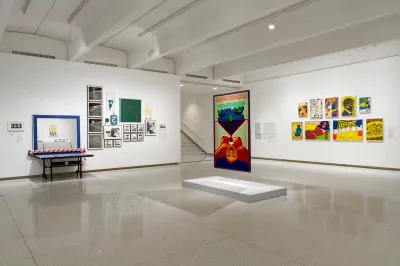
Image Credit: Photo Eric Mueller Vast, tough group shows are a dying breed in US museums—perhaps because they require so much from viewers, or maybe because institutions fear audiences simply won’t get them. Hats off, then, to the Walker Art Center for “Multiple Realities,” a 250-work show that reorients the conversation around art of the Eastern Bloc. Largely devoid of marquee names familiar to US art lovers, even those well-versed in recent art history, this show takes up feminist rebellions, daredevil stunts highlighting censorship, technological innovations, and more, all in a way that feels accessible. More crucially, the show fights back against Western assumptions about artists from the six countries surveyed: that all they produced was all dour all the time, and that they were cordoned from the rest of the world, with no ability to connect with others in different regions. Correctives like “Multiple Realities” are increasingly necessary as the canon continues to grow. Let it act as a guide for other future exhibitions in its vein. —Alex Greenberger
-
‘Woven Histories: Textiles and Modernist Abstraction’ at Los Angeles County Museum of Art
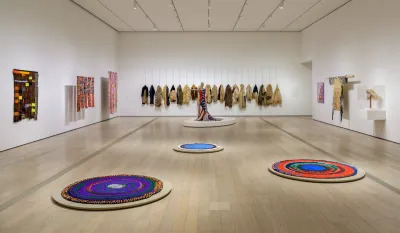
Image Credit: photo © Museum Associates/LACMA Exploring the intersection of abstract art and woven textiles, this exhibition brings together more than 150 pieces from the early 20th century through the present. The show, curated by Lynne Cooke, provides a comprehensive overview of textile production and what it means when it’s ported over into the realm of fine art. Though craft has gained traction among institutions in recent years, it has historically been overlooked as women’s work. Linking textiles and modernist abstraction, the show considers how both have been used as a tool to address political, social, economic, and aesthetic issues through works by artists such as Anni Albers, Jeffrey Gibson, Ulrike Mueller, Sophie Taeuber-Arp, and Andrea Zittel. It also offers a look at how contemporary artists are using textiles to approach community and identity politics. —Francesca Aton
-
‘Signals: How Video Transformed the World’ at Museum of Modern Art, New York
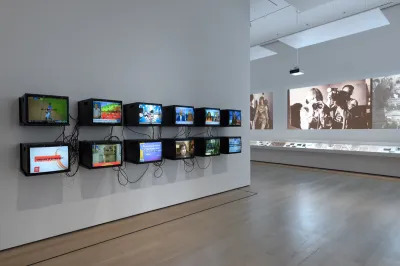
Image Credit: Photo Robert Gerhardt Credit due where credit is due: MoMA was a relatively early defender of video as an artistic medium, mainly thanks to curator Barbara London. But even at MoMA, video has often played second fiddle to painting and sculpture, and until 2023, there hadn’t been a big show devoted to the medium there in years. For that reason alone, “Signals” was a milestone within MoMA’s history, but the exhibition was also curatorially creative in ways that are rare for permanent collection presentations. “Signals” celebrated the political potential of video, showing how techniques like live-streaming, remixing, appropriation, and more can awaken new consciousness. Hong Kong’s 2019 protest movement, as seen through Tiffany Sia’s iPhone lens; rage over the horrors of the Gulf War, taped by the African American video collective Not Channel Zero; a shattering mirror on a Chinese street, shot by Song Dong: these were among the memorable moments in an exhibition chock full of them. —Alex Greenberger
-
‘African Modernism in America, 1947–67’ at Fisk University Galleries, Nashville, Tennessee; Mildred Lane Kemper Art Museum, Saint Louis, Missouri; and the Phillips Collection, Washington, D.C.

Image Credit: Photo Alise O’Brien/Courtesy Mildred Lane Kemper Art Museum, St. Louis In 1960, Nigerian artists Demas Nwoko and Afi Ekong crafted artworks that held a mirror in front of the country’s newly gained independence. Nwoko’s Folly portrayed a cockfight, a symbol of the political turbulence in nationalist and Pan-African politics. Ekong’s Olumo Rock was more subtle, capturing the craggy refuge of the Egba people during regional conflicts. These thought-provoking pieces were both part of “African Modernism in America, 1947–67,” which attests to the diverse artistic responses to midcentury shifts in the continent’s political and social landscapes.
The exhibition delves into the complex relationship between African artists and their American patrons, highlighting evolving Western perceptions of African art, and unravels the intricacies of philanthropic ties, CIA-backed funding, and ongoing disparities in the reception of African and Black art today. The exhibit’s finale, a collage installation by Ndidi Dike, pays homage to overlooked modernist women artists, underscoring African modernism’s historical relevance and its integration into Black institutions. —Daniel Cassady
-
Counterpublic, St. Louis
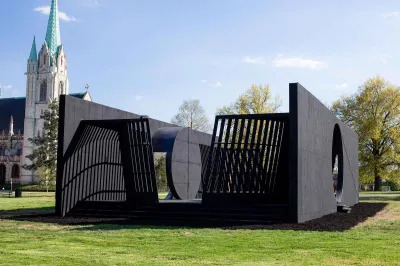
Image Credit: Photo Chris Bauer Art, at its best, encourages us to imagine better worlds. But when that art is public art—meaning it probably involves cumbersome committees and municipal permission—you tend to get less envelope-pushing, more consensus-approved likeability bordering on nothingburger. With a team of truly visionary curators, Counterpublic director James McAnally offered a bold new alternative for the second edition of this biennial devoted to public art. The civic exhibition engaged both temporary and permanent modes of memorial, most of which made visible the city’s Black and Indigenous histories. The organization did the important work of helping artists navigate logistical loopholes. They helped New Red Order point a billboard that reads “Got land? Give it back!” at two settlers’ homes sited right on Sugarloaf Mound—the last remaining Indigenous mound in an area once known for them. Steffani Jemison installed an audio installation in gondolas on the city’s ferris wheel: floating above the city, passengers heard names and locations of Black theaters that you can no longer see, since they’ve been lost to gentrification and demolition. As we continue to imagine what might replace the triumphantly toppled statues of Confederate soldiers, Counterpublic’s model and artists are good guiding lights. —Emily Watlington
-
‘Amalia Mesa-Bains: Archaeology of Memory’ at Berkeley Art Museum, California

Image Credit: Photo Daria Lugina Long a pillar of the Chicanx community, the artist, activist, and scholar Amalia Mesa-Bains finally received her flowers with her first retrospective. Best-known for installations that take the form of the home altar and the Día de los Muertos ofrenda, and bring it into a contemporary art context, she has often crafted pieces that do not remain the same over time: objects tend to migrate between her installations. That makes mounting a retrospective for her challenging, but curators María Esther Fernández and Laura E. Pérez successfully managed the feat, bringing together a suite of her most iconic works alongside lesser-known ones, like Circle of Ancestors (1995), whose inclusion showcases Mesa-Bains’s commitment to highlighting the lived experiences of women of color and the generations who have come before her. —Maximilíano Durón
-
‘Rirkrit Tiravanijia: A LOT OF PEOPLE’ at MoMA PS1, New York

Image Credit: Photo Kyle Knodell/Courtesy MoMA PS1 Rirkrit Tiravanija’s immersive works hinge on human interactions, and have involved serving soup, playing ping pong, and consuming coffee—all activities that don’t naturally lend themselves to being shown within the walls of a career-spanning exhibition. But these works were totally at home in the artist’s first US survey, which brought together more than more than 100 installations, films, drawings, works on paper, sculptures, re-staged performances, and related ephemera from the 1980s through the present. Tiravanija invited museumgoers to do more than just see his art. He wanted them to participate, too, a gesture that seems all the more relevant several years after the start of a pandemic that kept people from congregating for a while. —Francesca Aton
-
‘Myth Makers—Spectrosynthesis III’ at Tai Kwun Contemporary, Hong Kong

Image Credit: Photo South Ho/Courtesy Tai Kwun Contemporary Drawing together more than 100 works by some 60 artists from the holdings of collector Patrick Sun’s Sunpride Foundation, this exhibition explored how contemporary LGBTQ+ artists have addressed creating queer mythologies in their work. Among the highlights include photographs by Kohei Yoshiyuki capturing night-time cruising sites in Tokyo’s parks, a painted comic strip by Chitra Ganesh that begins with “Forever Her Fist,” an installation by Bruno Zhu showing how everyday household tools could be used to refashion one’s own body, an ornate Martin Wong painting of an erect penis, and Tseng Kwong Chi’s iconic photographs in his Mao suit at various landmarks. The show was not without its curatorial faults, but its presentation in Hong Kong, during the city’s Art Basel fair, is daring, especially in a part of the world where explicitly queer art is not often shown by museums. —Maximilíano Durón
-
‘Finnegan Shannon: Don’t mind if I do’ at Museum of Contemporary Art Cleveland, Ohio

Image Credit: Photo Jacob Koestler There’s a word for that particular kind of exhaustion that art institutions induce: “museum fatigue.” In a genius attempt to alleviate it all, the Brooklyn-based artist Finnegan Shannon proposed a solution for their exhibition at moCa Cleveland. While seated on a couch, works came to viewers by conveyer belt, sushi restaurant–style. The show practically begged visitors to slow down. On the wall, custom clocks told the day of the week rather than the hour of the day, as if to ask: Hey, what’s the rush? Shannon’s celebration of rest is born specifically of the disability justice movement, as works by their peers—fellow disabled artists—help make plain as they circulate. —Emily Watlington
-
‘Lin May Saeed: The Snow Falls Slowly in Paradise. A dialogue with Renée Sintenis’ at Georg Kolbe Museum, Berlin

Image Credit: Courtesy Galerie Jacky Strenz Days before this show opened, the Iraqi-German sculptor Lin May Saeed died at age 50 from brain cancer. The artist and activist dedicated her life to advocating for animals: their care, their liberation. With her sculptures, she wanted to give us a new iconography for human-animal relations—one centered on mutual, interspecies acts of care. Knowing her days were numbered, she gave the show a beautiful title: “Im Paradeis, fällt der Schnee langsam,” or, “In paradise, the snow falls slowly.” When it snows, I’ll think of her. —Emily Watlington
-
‘Indian Theater: Native Performance, Art, and Self-Determination since 1969’ at Hessel Museum of Art, Annandale-on-Hudson, New York

Image Credit: Photo Karl Rabe Of all the exhibitions surveying contemporary Indigenous art, this was perhaps the knottiest, with a multitude of paintings, sculptures, videos, and, of course, performances on hand that explored how Native identity is expressed. Curated by Candice Hopkins (Carcross/Tagish First Nation), the offerings skewed conceptual, making for difficult viewing that rewarded close contemplation. Across explorations of colonialism, feminist protest, and land rights, a common theme emerged: Indigenous artists have had to fight for their own subjecthood in a society that has tried to ground them down. A video by asinnajaq (Inuk), in which the artist lies supine and buries herself beneath a mass of rocks, then stands before she runs out of breath, acts as a metaphor for the show writ large. She use her performance to mirror the possibility of death, only to get right back up again. —Alex Greenberger
-
‘Made in L.A. 2023: Acts of Living’ at Hammer Museum, Los Angeles

Image Credit: Photo Joshua White Since launching in 2012, the Hammer Museum’s Made in L.A. biennial has successfully raised the national profile of the Los Angeles art scene, proving that it is more than a select few stars. This year’s astounding edition, titled “Acts of Living” and curated by Diana Nawi and Pablo José Ramírez, is another valuable contribution to that project, with works by 33 talented artists, including Esteban Ramón Pérez, Guadalupe Rosales, Ishi Glinsky, Jackie Amézquita, Joey Terrill, Kang Seung Lee, Teresa Baker, and Vincent Enrique Hernandez. Never before have Latinx, Indigenous, and Asian participants been so prevalent in a Made in L.A. artist list. For the first time, the show accurately demonstrates the true diversity of LA’s art scene. —Maximilíano Durón
-
‘Going Dark: The Contemporary Figure at the Edge of Visibility’ at Guggenheim Museum, New York
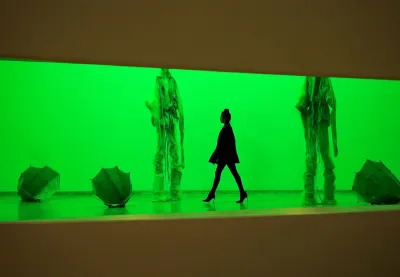
Image Credit: Photo Timothy A. Clary/AFP via Getty Images Things that go dark: windows, in a city besieged by bombs; communication, when affection reaches indifference; the soul, when society denies the existence of those who look, speak, and think differently. In a mesmerizing group show at the Guggenheim, 130 artists—including American Artist, Ming Smith, Farah Al Qasimi, WangShui,, and Doris Salcedo—consider invisibility and all that it offers. When facing individual scrutiny or state surveillance, some propose, it’s advantageous to disappear; others experience life as an unwilling twilight.
Take the imposing monochrome panel that towers above the rotunda: only by inspecting the back can you discover Lorna Simpson’s Specific Notation, in which a woman’s head breaches a craggy indigo ground. Blackness–and the American impulse to deny its social nuances–is explored across works by David Hammons, Faith Ringgold (present in a stunning painting), and Kerry James Marshall, all of whom abstract the human figure in some way. Marshall’s Invisible series, in which grinning Black faces bleed into a “heart of darkness”, will be the most recognizable entries in the show, not that that diminish their in-person power. You’ll want to re-read Ralph Ellison’s Invisible Man, which made indelible use of the paintings as cover art, later. “I am invisible,”Ellison’s nameless narrator says, “simply because people refuse to see me.” —Tessa Solomon

